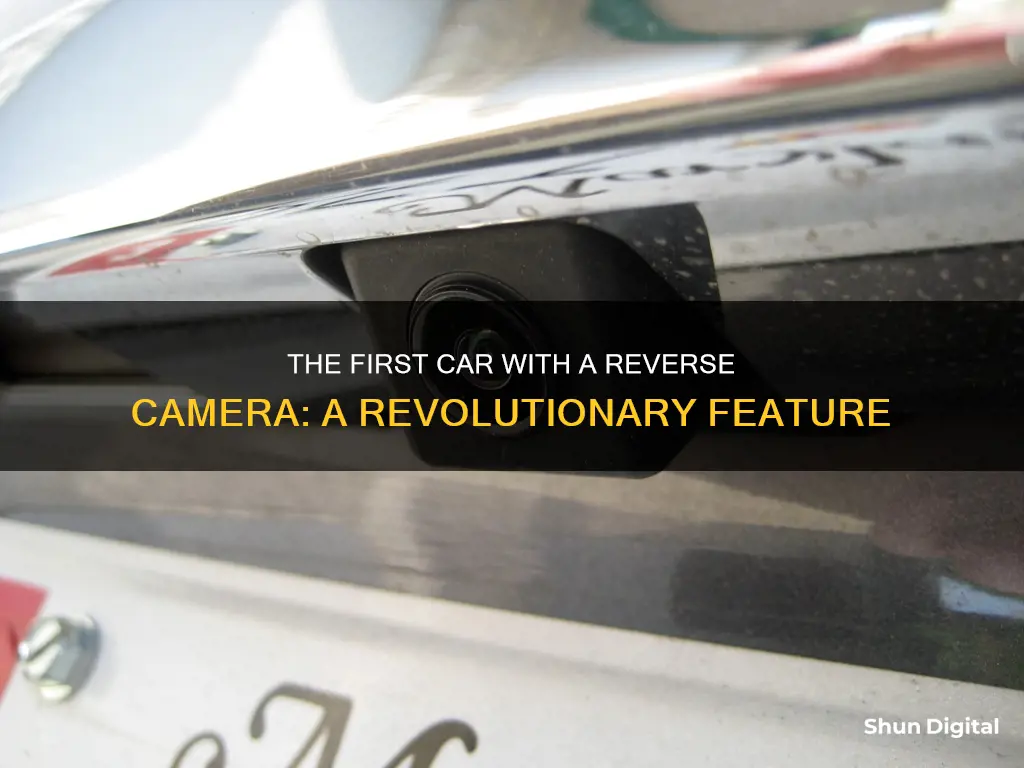
The first mass-produced car to feature a reverse camera was the 1991 Toyota Soarer Limited, which was only available in Japan. The Toyota Soarer's rear-view camera system featured a CCD (charged-coupled device) with a transistorized light sensor on an integrated circuit. This compact camera was fitted into the rear spoiler housing and transmitted a live colour feed to a dash-mounted screen, providing the driver with a clear view of objects below the rear-view mirror's line of sight. The system was discontinued in 1997.
| Characteristics | Values |
|---|---|
| Year | 1991 |
| Manufacturer | Toyota |
| Model | Soarer Limited |
| Market | Japanese |
| Camera Type | Charge-coupled device (CCD) with a transistorized light sensor on an integrated circuit |
| Display Type | Colour electro multi-vision (EMV) screen |
What You'll Learn
- The first car with a reverse camera was the 1956 Buick Centurion
- The 1991 Toyota Soarer was the first mass-produced car with a reverse camera
- Since 2018, all new cars sold in the US and Canada are required to have a backup camera
- Reverse cameras are also known as backup or rear-view cameras
- Reverse cameras have been proven to save lives

The first car with a reverse camera was the 1956 Buick Centurion
The reverse camera on the 1956 Buick Centurion was a large TV camera lens mounted at the rear of the car, with a screen located on the dashboard. This setup was bulkier and more conspicuous than modern reverse cameras, but it was undoubtedly cutting-edge technology for its time. The Centurion's reverse camera system was so advanced that it didn't need any mirrors on the car.
The 1956 Buick Centurion was a concept car, and the reverse camera technology it showcased didn't catch on for many years. It wasn't until 1991 that the first production car with a reverse camera was released—the Japanese-market Toyota Soarer Limited. This car featured a compact CCD (charge-coupled device) camera with a transistorized light sensor mounted in the rear spoiler, transmitting a live colour feed to a screen on the dashboard.
The 1956 Buick Centurion was a pioneer in automotive technology, and its influence can be seen in the reverse camera systems that are now standard in cars today. While the technology has evolved and become more integrated into vehicle designs, the basic concept of a rear-mounted camera aiding the driver's visibility remains the same. The Centurion's legacy can be seen in the improved safety and convenience that modern reverse camera systems provide.
Dome Cameras: Ultimate Discreet Surveillance Solution
You may want to see also

The 1991 Toyota Soarer was the first mass-produced car with a reverse camera
The Toyota Soarer Limited, also known as the UZZ31 and UZZ32, was a Japanese-market-only car. Its reverse camera system featured a colour EMV screen with a rear-spoiler-mounted CCD camera. This compact camera, fitted into the rear spoiler housing, provided a live colour feed to a screen mounted on the dashboard, giving drivers a clear view of objects below the rear-view mirror's line of sight.
The reverse camera system in the Toyota Soarer was a significant advancement in automotive safety. It offered a digital, colour image, in contrast to the bulkier video camera systems of previous concepts. The camera's placement in the rear spoiler housing was also innovative, providing a more streamlined and integrated design. This pioneering technology paved the way for further advances in reverse camera systems, such as computer-generated guidelines and multiple-camera setups offering a 360-degree view.
The Toyota Soarer's reverse camera system was discontinued in 1997, but its impact on the automotive industry was lasting. It demonstrated the feasibility and importance of reverse camera technology, which is now standard equipment in cars sold worldwide. The Soarer's legacy can be seen in the improved safety features and driving assistance systems found in modern vehicles, where reverse cameras have become an essential tool for drivers, enhancing visibility and reducing accidents.
Did I Get Snapped by a Speed Camera?
You may want to see also

Since 2018, all new cars sold in the US and Canada are required to have a backup camera
The first production car with a reverse camera was the 1990 Toyota Soarer Limited, available only in Japan. The system featured a compact CCD camera with a transistorized light sensor on an integrated circuit, fitted into the rear spoiler housing. This provided a live colour feed to a dash-mounted screen, giving the driver a clear view of objects below the rear-view mirror's line of sight.
Since the Toyota Soarer Limited's debut in 1990, backup cameras have become a standard safety feature in vehicles. In 2008, Congress passed the Cameron Gulbransen Kids Transportation Safety Act, which required the National Highway Transportation Safety Agency (NHTSA) to improve rear visibility in vehicles. Despite the bill's signing in 2008, the NHTSA's proposed standard was stalled for several years. It wasn't until March 2014, following a lawsuit from advocacy groups, that the NHTSA issued a rule with a May 1, 2018, deadline for full implementation.
Since May 2018, all new cars sold in the US are required to have backup cameras. This regulation was enacted by the National Highway Transportation Safety Agency to address the issue of drivers backing into people due to a lack of visibility. The rule was particularly aimed at preventing accidents involving children, who often fall victim to "backover" crashes. According to the Department of Transportation, over 200 people are killed and 12,000 injured each year in such incidents.
Canada followed suit, and since May 1, 2018, all new cars sold in Canada weighing 4536 kg or less must be fitted with a backup camera. This law was enacted by Transport Canada in response to alarming statistics. Between 2004 and 2009, 27 deaths and 1500 injuries occurred during backup manoeuvres, with many incidents involving young children who were not visible through standard rear-view mirrors.
Focusing Night Landscapes: Camera Tricks for Stunning Shots
You may want to see also

Reverse cameras are also known as backup or rear-view cameras
Reverse cameras, also known as backup or rear-view cameras, have been standard in all cars and light trucks manufactured for sale in the US since May 1, 2018. This was due to a federal requirement, following safety concerns and accidents caused by reversing cars.
The first car to feature a reverse camera was the 1956 Buick Centurion concept car, which was unveiled at the General Motors Motorama in 1956. The Centurion had a rear-mounted television camera that sent images to a TV screen on the dashboard, replacing the need for a rear-view mirror. However, the Centurion was just a concept car and the reverse camera didn't catch on for several decades.
The first production car to feature a reverse camera was the 1991 Toyota Soarer Limited, which was only available in Japan. The Toyota Soarer's system featured a compact CCD (charge-coupled device) camera with a transistorized light sensor on an integrated circuit. This was fitted into the rear spoiler housing and transmitted a live colour feed to a screen on the dashboard, providing a clear view of objects below the rear-view mirror's line of sight.
The Infiniti Q45, launched in 2002, was the first car to offer a rear camera in the US. The Rear-View Monitor was an optional feature that used a camera near the rear license plate, with the image displayed on a dashboard screen along with guidelines to help with parking.
Adjusting Midtones in Camera Raw: A Step-by-Step Guide
You may want to see also

Reverse cameras have been proven to save lives
The effectiveness of reverse cameras in preventing collisions is well-established. A 2019 study by the Insurance Institute for Highway Safety (IIHS) found that combining a reverse camera with rear parking sensors reduced backup collisions by 42%. Adding automatic rear braking to this setup further lowered the collision rate by 78%.
The history of reverse cameras in automobiles goes back decades. The first vehicle to feature a reverse camera was the 1956 Buick Centurion concept car, unveiled by General Motors in 1956. This innovative system allowed the driver to see behind the car without turning around, and it was so reliable that the Centurion had no mirrors. Despite this early debut, it would take decades for reverse cameras to become standard in production cars.
The first production car to incorporate a reverse camera was the 1991 Toyota Soarer Limited, sold exclusively in Japan. This was followed by the 2002 Infiniti Q45 sedan, which offered a rear-view monitor as an optional feature. Since then, reverse cameras have become increasingly common, with some manufacturers making them standard even before the 2018 mandate.
Reverse cameras have undoubtedly played a crucial role in enhancing driver awareness and reducing accidents. Their ability to eliminate blind spots and provide a clear view of the vehicle's surroundings has made a significant impact on road safety.
Understanding Slave Mode Functionality on Cameras
You may want to see also
Frequently asked questions
The first-ever produced car with a reverse camera was the 1991 Toyota Soarer Limited. However, it was only available in Japan.
The first car with the potential for a reverse camera was the 1956 Buick Centurion concept car. It featured a rear-mounted camera that sent images to a dashboard screen, removing the need for a rearview mirror.
Backup cameras became mandatory in the US on May 1, 2018.







